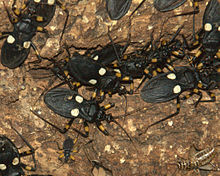- Platymeris
-
Platymeris 
Platymeris biguttatus Scientific classification Kingdom: Animalia Phylum: Arthropoda Class: Insecta Order: Hemiptera Suborder: Heteroptera Superfamily: Cimicomorpha Family: Reduviidae Subfamily: Reduviinae Genus: Platymeris
DistantPlatymeris is a genus of assassin bug (reduviidae). Platymeris species are often used in laboratories and as pets. The venom of this genus has been studied in a laboratory setting.
Contents
Species list
Platymeris biguttatus
Platymeris charon
Platymeris erebus
Platymeris flavipes
Platymeris guttatipennis
Platymeris insignis
Platymeris kavirondo
Platymeris laevicollis
Platymeris nigripes
Platymeris pyrrhula
Platymeris rhadamanthus
Platymeris rufipes
Platymeris swirei
Platymeris biguttatus originates from West Africa, particularly the Togo region. The adults are approximately 5 centimeters long and live in a dry climate.
Captive care
These insects are relatively easy to keep. They need a medium sized terrarium with many hides like bark and a good substrate is vermiculite or cork bark. They feed on many commercially available insects such as superworms, crickets, waxworms, locusts, etc. Development from nymph to adult takes about 9 months; and adults live for about two years.
Breeding
Breeding is easy if you have both sexes. The female has a small slit in the end of her abdomen. The eggs are laid on the substrate and can be hard to spot. The tiny nymphs hatch about three weeks after being laid. First instar nymphs can be fed pinhead crickets and fruit flies and should be misted every other day in order to achieve successful molts.
Temperature and humidity
The optimum temperature is 25 C for these animals and low humidity for adults. A weekly spray with water is appreciated as the Assassin Bugs will suck the water droplets with their rostrum.
Bite
In order to liquify the contents of their prey, they use powerful toxins and enzymes. These insects can spit these enzymes in your eye causing severe irritation to temporary blindness if not washed with water. The bite is very painful and allergic people should take special care with these insects. When agitated, a droplet of these toxins is visible on its rostrum.
References
- "Bugs of the World" by George McGavin, ISBN 978-0713727869
- "Insects,Spiders and Other Terrestrial Arthropods"[1] by George McGavin
- Easy Insects: "How to keep Platymeris biguttatus"
Categories:
Wikimedia Foundation. 2010.
